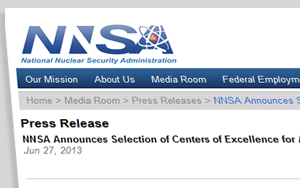 Press Release from the National Nuclear Security Administration Website, June 27, 2013.
Press Release from the National Nuclear Security Administration Website, June 27, 2013.WASHINGTON, D.C. – The National Nuclear Security Administration (NNSA) today announced the selection of its six new centers of excellence whose primary focus will be on the emerging field of predictive science.
Six universities were selected either as a Multidisciplinary Simulation Center (MSC) or as a Single-Discipline Center (SDC). The MSCs will receive $3.2 million and the SDCs will receive $1.6 million each year for five years under NNSA's Predictive Science Academic Alliance Program II (PSAAP II) agreement.
The six universities include:
• University of Utah, Salt Lake City, Utah, "The Uncertainty Quantification-Predictive Multidisciplinary Simulation Center for High Efficiency Electric Power Generation with Carbon Capture," an MSC
• University of Illinois-Urbana-Champaign, Champaign, Ill., "Center for Exascale Simulation of Plasma-Coupled Combustion," an MSC
• Stanford University, Stanford, Calif., "Predictive Simulations of Particle-laden Turbulence in a Radiation Environment," an MSC
• University of Florida, Gainesville, Fla., "Center for Compressible Multiphase Turbulence," an SDC
• Texas A&M University, College Station, Texas, "Center for Exascale Radiation Transport," an SDC
• University of Notre Dame, Notre Dame, Ind., "Center for Shock Wave-processing of Advanced Reactive Materials," an SDC
"We expect the PSAAP alliances will continue to help develop the predictive science field and the workforce of the future, wherein simulations will be pervasive and instrumental in important, high-impact decision-making processes," said Robert Meisner, director of the NNSA Advanced Simulation and Computing (ASC) program.
Since the cessation of underground nuclear testing, NNSA has used simulation and modeling tools and capabilities developed by the ASC program to support assessment and certification of the nuclear weapons stockpile. ASC’s academic alliances provide a training ground where graduate students and post-doctoral researchers gain and hone skills necessary to carry out large-scale simulations.
Predictive science is the application of verified and validated computational simulations to predict the behavior of complex systems where routine experiments are not feasible. The selected PSAAP II centers will focus on unclassified applications of interest to NNSA and its national laboratories – Lawrence Livermore National Laboratory, Los Alamos National Laboratory and Sandia National Laboratories.
The PSAAP II centers will develop the science and engineering models and software for their large-scale simulations utilizing methods of verification and validation and uncertainty quantification, with an additional focus on extreme-scale computing. The goal of these disciplines is to enable scientists to make precise statements about the degree of confidence they have in their simulation-based predictions.
